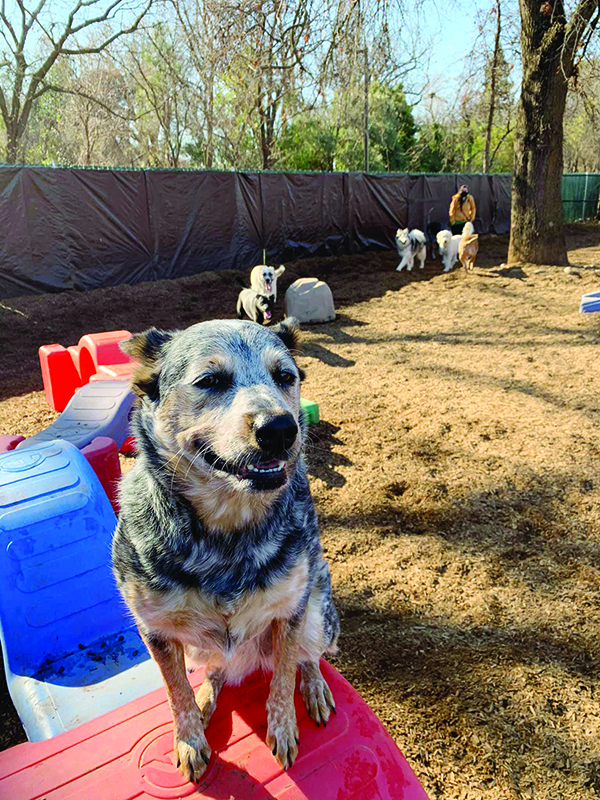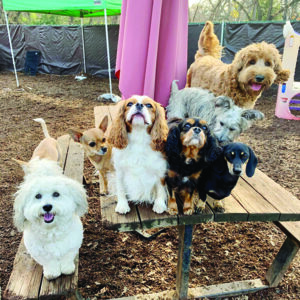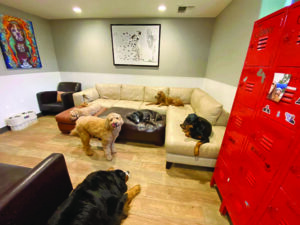
Many modern dog owners turn to dog daycare facilities as a source of socialization and exercise, especially in cases where dogs are otherwise home alone for the owner’s full workday.
We’ve all heard the saying, “A tired dog is a good dog,” but there’s a vast difference between a dog who sleeps because he’s tired and content, and a dog who sleeps because he’s exhausted from a stress-filled day. Dogs who spend much of their day engaged in exciting activity, such as the group play often found in poorly run daycare settings, actually experience a great deal of arousal. Arousal comes with a rush of adrenaline and cortisol, which are stress hormones. Prolonged elevated levels of stress hormones aren’t healthy – for pets or people!
DOG DAYCARE SHOULDN’T BE A FREE-FOR-ALL
It’s important to understand that all dog daycare facilities are not created equal. Generally, knowledgeable trainers agree that daycare facilities where large groups of dogs have access to free play for the majority of their visit (we’ll call those facilities “traditional daycare”) aren’t in the best interest of most dogs.
“Long periods of forced social time in a large group of potentially conflicting personalities can cause a lot of tension,” says Ashlee Osborn, KPA-CTP, CPDT-KA, of Bonafide Dog Academy in Omaha, Nebraska. “Large group play causes heightened arousal, even in dogs who really enjoy it. This can lead to a variety of undesirable behaviors such as mouthing, jumping, barking, humping, and even fighting.”
Osborn oversees Bonafide Dog Academy’s Bonafide Day Academy, a training and enrichment-focused daycare program with an overall focus on behavioral and mental wellness. Bonafide’s model limits free play in favor of activity-focused play, simulated off-leash walks using a long line, nosework games, calming food puzzles, manners or sport-dog training, and interactive play with staff.
Group dog play typically consists of two compatible dogs paired together, or occasionally, in small groups of not more than three to five dogs. Activities are punctuated with structured downtime, with a goal of making sure each dog enjoys at least an hour of uninterrupted sleep during the day.
Bonafide’s program is dramatically different from some of the traditional dog daycares we’ve seen where, often, groups as large as 30 or more dogs spend the day in a community setting, being separated from the group only as a “time out” for exhibiting undesirable behavior. Often, proprietors of such facilities just don’t know any better.
“Much like dog training, dog daycare is an unregulated industry,” says Mandy Eakins, KPA-CTP, CPDT-KA, owner and trainer at Manners Matter Dog Training and Daycare in Nicholasville, Kentucky. “Anyone can open a daycare. Just because someone really likes dogs, and has had dogs, does not make them qualified to oversee groups of dogs.”

Collars can be a hot topic when it comes to dog-to-dog play. While some people appreciate the ability to quickly grab a collar in an emergency, others fear – with good reason – the risk of injury (or worse!) that can occur when a dog accidentally gets his jaw stuck in the collar of a playmate.
In some cases, the use of collars can be helpful to tell similar-looking dogs apart or to remind staff of specific details related to a specific dog; one facility we know uses color-coded breakaway collars to identify intact dogs and dogs with food allergies.
Having heard far too many horror stories about collar-related strangulation, we’d advise looking for a facility that either removes collars completely or trades the dogs’ regular collars for breakaway collars. If facility staff suggests that quickly grabbing collars is necessary for the general management of dogs in a group setting, this might suggest the overall environment is not structured in ways that set dogs up for success.
WHAT TO LOOK FOR
When considering dog daycare, it’s important to do your research. While we advise looking for a daycare that emphasizes enrichment over long hours spent “free ranging” with other dogs, no matter the facility, we recommend considering:
* Admissions process. A reputable daycare should ask for background about your dog’s behavior and medical history, as well as conduct an evaluation prior to welcoming your dog into the program. It’s important to be honest when completing intake paperwork and discussing your dog. The more the facility staff knows about your dog, the better prepared they’ll be to help create a positive experience at daycare.
When it comes to accepting intact dogs, policies vary. With more pet owners leaning toward delaying spay/neuter until after 1 year of age, some daycare facilities are more flexible about welcoming intact dogs. Obviously it’s important to closely manage intact dogs in a group setting, so be sure to ask questions. How are intact dogs incorporated into a play group?
* Is daycare right for your dog? Not all dogs enjoy the company of other dogs – especially groups of other dogs, and that’s okay! Eakins says younger dogs with an easy-going play style tend to do best in a group play setting. Adult dogs who haven’t been exposed to group play are less likely to integrate successfully.
If you’re considering daycare because your dog otherwise sleeps all day and you think he’s bored, consider this: Dogs are crepuscular, meaning, they are naturally most active at dawn and dusk. It’s perfectly normal for dogs to spend much of their days asleep!

* Group size, selection, and amount of free play. When it comes to group play, less is more! Dogs typically play in pairs, even when in a group setting. Watch a group of dogs. It’s pretty easy to spot which two are actively playing together, and which dogs are on the outskirts of the interaction, trying to lobby their way in.
We recommend looking for a facility that limits group size to a maximum of 10 dogs together at a time, matched based on both size and play style, with at least two knowledgeable and skilled humans overseeing the activity. Even a high-volume facility can accomplish this by rotating dogs between group playtime and rest breaks, which are key to preventing over-arousal.
“Dogs need time to decompress,” says Osborn. “Anything longer than an hour of group play at a time is going to be too much for most dogs.” For some dogs, play lasting more than 20 to 30 minutes can begin to send them over the edge.
Areas for downtime should be completely out of view of group play to promote rest and prevent frustration behaviors. Dogs who actively ignore group interaction should have an easy way to opt out in favor of an activity better suited to their general temperament or their mood that day.

* Facility design and safety. Play space should be free from hazards, well ventilated, and have a non-slip surface with good drainage. Messes should be cleaned immediately using an animal-safe disinfectant. Toys, bowls, and kennels should be cleaned daily.
Facilities should insist daycare participants have, at a minimum, any vaccines required by law. Dogs exhibiting signs of illness (diarrhea, vomiting, coughing, runny nose, etc.) should not be allowed to participate. The facility should have a detailed emergency plan – in writing – and be able to explain, at least briefly, how an emergency evacuation would take place.
“At Manners Matter, our city emergency response knows dogs are on the premises, and an animal shelter emergency vehicle will be dispatched for any calls from our facility,” says Eakins. The team also practices emergency drills ranging from severe weather to breaking up fights.
* Staffing and staff education. “A good daycare provider should use proactive management to prevent problems and aim to set up dogs for success,” says Osborn. If spray bottles, shake cans, citronella collars, or worse, electric collars, are the go-to on the play floor, that’s a huge red flag. A good facility will create smaller playgroups, and constantly adjust the mix of individuals in groups to keep play from spinning up into overstimulation.
The ability to set up dogs for success requires a knowledgeable staff led by a management team committed to continuing education. Ask how the staff has been educated about dog body language and behavior; the answer should include some formal learning with professional materials, not simply a number of years of experience with dogs. As you listen to the answer, pay attention: Does anyone casually throw around words like “dominant” or “stubborn?” (Those are red-flag words that would not be used in a facility committed to a dog-friendly approach.)
If a facility touts “certified” trainers, ask questions about the certification. Do trainers rely on positive reinforcement or do they call themselves “balanced,” which often implies a willingness to use strong aversives, even outside of emergency situations. Make sure the facility employs enough qualified staff to ensure dogs on the group play floor are always properly supervised and never left alone.
* Too much of a good thing? Even the most enrichment and wellness-focused daycare facility can be too much for most dogs to attend daily. “Very few dogs do well attending daycare five days a week,” says Eakins. Over-stimulation is just as bad as under-stimulation, and dogs need time to rest and recover from the excitement of daycare.
Consider limiting daycare to a couple of consistently scheduled days per week (to help keep compatible play groups intact) with a day or two break between visits.
If you think your dog needs more interaction during the week, try looking for a dog walker who can offer your dog lower-key activities on the “off” days.






Great article on Dog Daycare. Thank you
Good article up until you throw half of your dog training peers under the bus by insisting “balanced” trainers rely on “strong aversives”. Balanced, reputable trainers use all four quadrants of operant conditioning, instead of just one or two.
Thank you for your comment. I agree with you. I had my own doggie daycare for a few years. I don’t understand why a shake can or spray bottle used properly is a red flag. The dogs that came to my farm for daycare loved coming. But they only came once or twice a week. They had to go down for a nap for a couple of hours while there with a Kong to enjoy. But I did use water as a way to divert a problem. Usually they were all too busy playing ball or catching a disk to get into trouble n
I was going to share this article like crazy because it’s how my daycare is run until you had to bash balanced dog trainers. Balanced doesn’t mean abusive. Otherwise a great article but too bad you decided to throw in unnecessary bias at the end. You could have appealed to everyone in the dog trainer world with this but nope.
She never claimed that “balanced” trainers rely on “abusive” methods. I consider myself a positive trainer and I have a question for “balanced” trainers. And this is a serious question. I’d like your explanation, please. In positive training, we work on building trust and communication with our dogs. We put “deposits” in the bank so we have a “cushion” of trust there for times when we need to do something the dog may not like–like the time our dog (whois now left us and I miss her every day) had a small scratch on her cornea. There was no time to “condition” her to eye drops–she needed drops and needed them now. Of course she wasn’t crazy about them, but we had enough “money” in the bank that she would cooperate and take them. But if you use positive punishment, you keep making “withdrawals” of the money you’ve “saved” using positive reinforcement. Why would you risk running out of that “cushion”? Why would you risk losing the trust of the dog? Why would you risk losing the communication you’ve managed to build up with that dog? If you’re “sold” and you’re a “balanced” trainer–fine. But don’t expect me to ever come to you with a problem one of my dogs is having. I’m not a professional trainer, just an owner who enjoys training her own dogs and who finds the use of positive reinforcement (with a small slice of negative punishment added if needed–got a teething puppy and he’s learned quickly that if he uses “mommy’s” fingers as his teething ring, all petting and attention goes away) is the best way to build a great relationship with my dogs and have clear communication with them. I’m not going to use any positive punishment on my two unless lives depend on it (and then I won’t use it–I’m not qualified to use it; I’ll call in someone who IS qualified to use it). And I’m going to try to not put them in situations in which I know they’ll be overwhelmed and uncomfortable so I can use negative reinforcement. Our little teething puppy sometimes displays “small dog syndrome”. I won’t “have” that, but don’t use negative reinforcement. I am much happier using desensitization and counterconditioning and he now plays fine with larger dogs (under strict supervision by ME and if the larger dog displays body language I don’t like or I see my little guy getting overwhelmed, I STOP play immediately).
I couldn’t help but notice a trainer of one on one is saying group play is not good….huh! I’ve done this for 10 years- no fights, no barking and the dogs all get mental and physical work….all 150 a day. Maybe visit a few before your next article… just sayin.